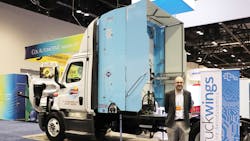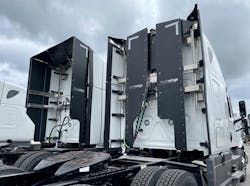As fuel prices soar, next gen of TruckWings takes flight
After analyzing data from 500 million miles of use, TruckLabs has updated the design of its flagship TruckWings automatic tractor-trailer gap closure device for easier installation and operation. The data also showed the aerodynamics device provides on average 4-6% fuel efficiency savings when the TruckWings are in operation. They pneumatically deploy from a retracted state using the air system at speeds over 50 mph.
These air-powered aluminum flaps are just the thing to ease the burden of soaring diesel prices, though they can benefit tractor-trailers of any flock. This includes diesel, CNG, and battery-electric.
Daniel Burrows, CEO of TruckLabs, explained that because CNG trucks have the largest gap, they have the highest savings of about 5-6%. Day cabs are next at 4-5%, and sleeper cabs will realize around 2.5-4% in savings.
“With the release of our third generation platform, we’re excited to extend these fuel savings to any fleet, any tractor, and any fuel type,” Burrow said. “We have significantly decreased TruckWings’ installation time and total cost, and enhanced durability and longevity, so that fleets can realize fuel savings benefits faster and longer.”
The Gen 3 TruckWings improvements include:
- A pre-assembled system design for reduced installation time from eight to two hours, as well an ability for fleets to transfer the device from one truck to another. This also allows more field installs and faster modification center throughput.
- Repositioned and hardened sensors and wire harness to gain IP67 rating.
- New double-hinge configuration (from chunky single hinge) to open and close the wings, which reduces system weight and more evenly distributes cross wind loads.
- Quick-service bushing set that can be swapped out in less than 10 minutes; this is recommended after 300,000 miles of use.
- Flexible edges to reduce damage upon minor contact.
Through the Redwood, California, company’s telematics component, TripDynamics, fleets can also track miles driven, miles the TrucksWings were deployed, and exception reports for instances they did not deploy when they should. Larger fleets may also want to leverage the software’s detailed carbon level by state data for sustainability reporting.
“Everyone knows the tractor-trailer gap is a problem,” Burrows told Fleet Maintenance. “We validated the savings, and now we've got half a billion miles of running on our system. We folded all that into the best possible lowest cost system for fleets.”
While discussing the changes in March at American Trucking Associations’ Technology & Maintenance Council 2022 Annual Meeting & Transportation Technology Exhibition , Burrows also pointed out that TruckWings safeguards against accidental damage by controlling when they can open. A sensor detects when a trailer is attached, which prevents deployment. A toggle switch inside the cab allows opening and closing when the trailer is not hitched.
The units cost about $5,000 (though the price varies on model and units ordered) and are designed to last 1 million miles; so, at 5% fuel savings, day cabs can start seeing an ROI in a few years. With TripDynamics, fleet will be able to see how often the TruckWings are deployed and thus saving money. Even for regional haul, this happens more often than one may think based on a truck’s average speed. Burrows explained that fleets might look at their average speed of 42 mph and believe because TruckWings deploy at 50 mph, they will not see a big benefit.
“In reality it’s very bimodal—fleets are either going 5 mph or 60 miles an hour,” he said. “We had one fleet that reported an average of 42 mph, and TruckWings could still be deployed 80% of the time with that fleet.
“It's a big misconception that if you’re only doing short routes, it doesn't make sense,” he added. “It turns out the day cabs doing short routes are some of our best applications.”
Because TripDynamics breaks down which states the truck reduced fuel usage and generated fewer emissions, fleets will also see benefits to sustainability reporting.
Looking forward, Burrows believes the aerodynamics device will provide greater advantages to electric vehicles by extending their range. TruckWings can extend the range by about 10 miles for electric trucks that would otherwise get 150 miles per charge, Burrows said.
An undisclosed OEM TruckLabs is working with has reported 5% fuel savings with TruckWings deployed.
“It's so much cheaper than that bigger battery pack and more charging infrastructure,” he asserted.
Overall, Burrows concluded TruckWings is a powertrain-agnostic efficiency tool.
“Two-thirds of your fuel at highway speeds is spent overcoming aerodynamic drag, regardless of the fuel source,” he explained. “It's great to talk about electric, but there's also reality of what's being shipped right now. And aerodynamics can improve diesel trucks today, and also enable a pathway to electric trucks or alternative trucks in the future.”
About the Author

John Hitch
Editor-in-chief, Fleet Maintenance
John Hitch is the award-winning editor-in-chief of Fleet Maintenance, where his mission is to provide maintenance leaders and technicians with the the latest information on tools, strategies, and best practices to keep their fleets' commercial vehicles moving.
He is based out of Cleveland, Ohio, and has worked in the B2B journalism space for more than a decade. Hitch was previously senior editor for FleetOwner and before that was technology editor for IndustryWeek and and managing editor of New Equipment Digest.
Hitch graduated from Kent State University and was editor of the student magazine The Burr in 2009.
The former sonar technician served honorably aboard the fast-attack submarine USS Oklahoma City (SSN-723), where he participated in counter-drug ops, an under-ice expedition, and other missions he's not allowed to talk about for several more decades.

